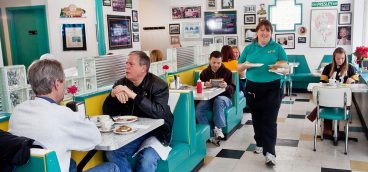Night drivers in western Pennsylvania will know the quickening experience when a deer is caught by the car’s headlamps. Usually it’s a momentary, harmless event, but always a bit of a shock. Filmmakers (Jean Cocteau, Alfred Hitchcock, David Lynch) use the same kind of device to sometimes devastating effect. In black and white, it works especially well.
In the Carnegie Museum of Art’s Forum Gallery, it’s not a deer, but a stone ram caught in the flashlight, that catches your eye in a 16mm silent, color (but read it as black and white and gold) film by Rosalind Nashashibi and Lucy Skaer. The artists pass though the Metropolitan Museum in the dead of night, encountering works of art suddenly in almost brutal encounters. Here flashes of light, there correspondent dramatic shadows. Off… on… off…on, panning through display cases to alight on what becomes almost a target. Objects normally seen in the cool, moderate light of day become changed, or reanimated. And, importantly, the viewer’s subconscious is enlisted to provide visual drive (a ploy of classical surrealism). The continuous loop is hypnotic.
Elsewhere in this dark, undefined Forum space, another 16mm film projects smallish photographs scanned by the Library of Congress onto a larger screen. They are images shot by now-famous photographers (Evans, Lange, Shahn) for the Farm Security Administration during the Great Depression. They depict and survey, in the broadest of terms, American life. In fact, they may have come to define the period. Roy Stryker, the highly respected editor of this series (he did similar work in Pittsburgh), had absolute control over this material. (The photographers, it should be noted, had no rights over their material under the terms of their agreement with the government.) Stryker “killed” many of these images by puncturing a hole in the negative.
William E. Jones, the author of the film “Punctured,” whose real interest is in how power is exercised, homes in on this element, questioning the motives of editorialism. Thus he picks away at Stryker’s reputation. The looped film moves out from the black hole, revealing what remains of the image—silent testimony to a traumatic period in the American psyche. The void initiates the next photograph and the next, adding worth and new significance to these destroyed images. Again, hypnotic. This may not be Jones’s most radical film but, in its way, is almost perfect in its measured gravity.
I think I knew that by dancing vigorously I could cure the bite of the tarantula. But if you have missed out on that useful bit of boy scout’s campfire chat, the museum text puts that legend in a proper context with its southern Italian origins. Anyway, the body is a strange place even now, and here the artist Joachim Koester refers to it as terra incognita, as an ancient map refers to places unknown. Koester explores this dance as something willed and unwilled and choreographs a work for six dancers, which he layers together in this looped (and, again, hypnotic) work. What results is not so much an apotheosis of that particular dance but a transformative baring of very raw essentials.
The Forum 65 show, which goes under the name “Reanimation” and runs until Oct. 3, is the first obvious curatorial foray by Associate Curator of Contemporary Art Dan Byers, who has been in Pittsburgh for more than a year. It takes place in what is the most interesting space in the Museum of Art, but which is often the least well occupied. Three video pieces in a single space is a risk, but it works remarkably well here, being nicely balanced in terms of sensibility and scale. (A previous curator once explained to me that a museum normally has to space film and video installations through museum galleries with care, and not successively.)
A year is about enough time for a curator to begin to make a mark. Byers has already started to rehang the contemporary galleries in the Scaife wing, introducing some new acquisitions and changing some emphases. If you are closely familiar with the museum, you will see this change happening, but Byers has more radical plans in the works and is unafraid to express them.
I am happy to say how relieved I am that the Three Rivers Arts Festival has survived its recent turmoil and reincarnation under the umbrella of the Cultural Trust. Early days yet, but there were some very useful auguries this summer.
The Associated Artists of Pittsburgh are well under way in their centennial year. The 100th Annual Exhibition is showing at the Carnegie Museum of Art until September 19th, juried by Donald Miller, sometime art critic of the Post-Gazette, and A.B Miner, independent curator and curatorial assistant at the Hirshhorn Museum and Sculpture Garden in Washington, D.C.
And not to be missed in the heat of summer is “Twisted Pair: Marcel Duchamp/Andy Warhol” at the Warhol Museum (until September 12th). It is curated by Matt Wrbican, the museum’s archivist, who produces somewhat infrequent but always interesting exhibitions.
This is perhaps his most important to date and traces the relationship between these two artists. You will find people who cannot decide which of the two was greater or more influential. Wrbican draws hugely on his archive, and, more than ever, we have come to realize that archives authenticate institutions, more than memory or opinion.
In the next issue of Pittsburgh Quarterly, I hope to consider more of the newcomers in the cultural field here, and how they change the community for good. And, if my sources serve me well, information about events that may leave us a little saddened.





